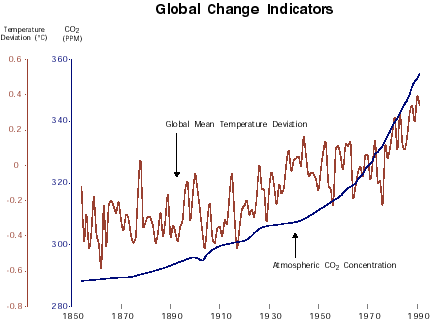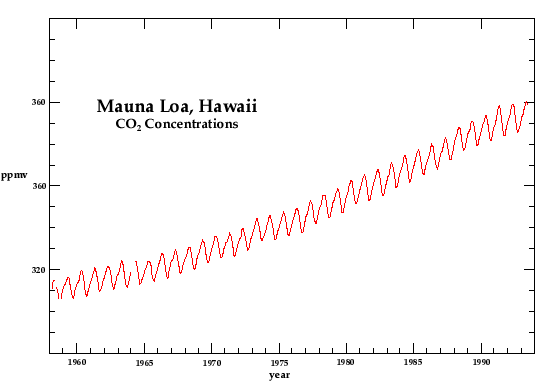


Global Warming: A remarkable global warming trend has become evident since 1900. It is thought to be driven by the rapid increase in atmospheric CO2 and other greenhouse gases due to modern human activities.

Atmospheric CO2 measured at Mauna Loa, Hawaii. The yearly minima occur towards the end of growing season in the Northern Hemisphere.
(1) The anthropogenically generated greenhouse gases in the atmosphere are increasing rapidly and will almost certainly continue to do so for at least several decades. The United States is the largest producer of greenhouse gases. In 1993 the President spoke of trying to reduce the emission of greenhouse gases to the 1990 level by the year 2000. However in the fall of 1997 the Energy department announced that in the United States, energy source emissions had actually increased by 8% from 1991 through 1996. The rapid development of the poorer nations is also contributing an ever increasing share of the production of these gases.
(2) The IPCC panel agreed that the increase of greenhouse gases over the last 100 years has caused a noticeable global warming. There is considerable variability in the 'natural' climate system and this is not yet entirely understood. Thus the human driven warming is just beginning to emerge from the noise. However the warming signal is expected to become very clear in a few decades due to the rapid increase in the greenhouse gases.
(3) Present climate prediction models can give only a rough idea of what the results of global warming will be. Some agreed-upon effects include a rise in sea level and a warmer, moister climate at high latitudes. Changes in regional surface temperatures and precipitation patterns are expected to cause considerable perturbations in present global agricultural patterns. However the prediction models are not accurate enough to tell us exactly what these future patterns will be. A strong effort to slow the growth of atmospheric greenhouse gases would help some, but the Earth's population must learn to adapt to the changing conditions. Both the slowing of the greenhouse gas emissions and the adaptation to change present scientific and political challenges.
The Earth's climate and biosphere are driven by the absorption of shortwave, high energy, photons from the Sun. The exhaust heat is ultimately radiated to cold space in the form of longwave, low energy, photons. How much energy is absorbed, where geographically and at what time of the year, are important climate parameters. The fractions that are absorbed at the surface and in the atmosphere are also important. The same is true for the exhaust radiation. Clouds, and to a lesser extent aerosols, can effect both the Earth's absorption and emission of radiation. An increase in cloud cover decreases the solar radiation reaching the surface while at the same time increasing the downward longwave radiation at the surface. The net warming or cooling effect of the cloud depends on many factors including the cloud's altitude, optical thickness, and the clear sky insolation. Both measurements and theory indicate that the Earth-atmosphere system is close to a steady state condition in which the absorbed and emitted radiant energy balance over the course of a year (Barkstrom et al., 1989). When the absorbing and radiating patterns are changed, the Earth's climate has to adjust. This is termed 'radiative forcing of climate'. Increasing the amount of greenhouse gases in the atmosphere produces such a radiative forcing of climate.
General circulation models (GCM) and particularly coupled atmosphere-ocean models are the preferred tools for studying the complex interactions associated with global warming and radiative forcing of climate. Although not perfect, these models enhance our ability to understand the climate system and possible future climate changes. The IPCC (1995) study (p. 5) states: "Our ability to quantify the human influence on global climate is currently limited because the expected signal is still emerging from the noise of natural variability, and because there are uncertainties in key factors. These include the magnitude and patterns of long-term natural variability and the time-evolving pattern of forcing by, and response to, changes in concentrations of greenhouse gases and aerosols, and land surface changes. Nevertheless, the balance of evidence suggest that there is a discernible human influence on global climate." Climate changes of note during the last century include a global sea level rise of between 10 and 25 cm and a global mean surface air temperature increase of between about 0.3 and 0.6 degrees centigrade. Night-time temperatures over land have generally increased more than daytime temperatures. (IPCC 1995, p.4) " ... the recent warming has been greatest over the mid-latitude continents in winter and spring". In addition "precipitation has increased over land in high latitudes of the Northern Hemisphere, especially during the cold season."
It is expected that the human influence on climate will become very visible in the 21st century. Modelers have tried to see what the climate may be like in 2100 (IPPC 1995, p. 5). "The IPCC has developed a range of scenarios, IS92a-f, of future greenhouse gas and aerosol precursor emissions based on assumptions concerning population and economic growth, land -use, technological changes, energy availability and fuel mix during the period 1990 to 2100. Through understanding of the global carbon cycle and of atmospheric chemistry, these emissions can be used to project atmospheric concentrations of greenhouse gases and aerosols and the perturbation of natural radiative forcing. Climate models can then be used to develop projections of future climate." The scenarios include a probability range from best case (extreme corrective action) to worst case (little corrective action) with the 'most probable' lying in-between. In 2100 it is predicted, that relative to 1990 the most probable global mean temperature will be 2 degrees C higher (+1 to +3.5 degrees C). (IPCC 1995, p.6) "Because of the thermal inertia of the oceans, only 50-90% of the eventual equilibrium temperature change would have been realized by 2100 and temperature would continue to increase beyond 2100, even if concentrations of greenhouse gases were stabilized by that time." The mean sea level should have risen another 50 cm (15 cm to 90 cm) by 2100 and should continue to rise even after the global mean temperature becomes stabilized.
Other important questions involve how the polar ice sheets will melt, and just how the Earth's carbon cycle works and how it might change as the climate warms. In the most probable scenario, most of the rise in sea level by 2100 will be due to thermal expansion of the water as the mean temperature rises. However if high ice melting should occur, the sea level would rise by 90 cm instead of the expected 50 cm. The human input of CO2 into the atmosphere constitutes only a small fraction of the natural carbon cycle. The normal cycling of CO2 between the atmosphere and the land and ocean constitutes the vast majority of the total. The problem is that the natural cycle is close to equilibrium, In the natural cycle about as much CO2 is absorbed from the atmosphere as is released to it. However, the anthropogenic CO2 has unbalanced the system. It tends to go into the atmosphere and stay there for many years. At present the new excess of atmospheric CO2 is being slowly absorbed back into the land and ocean, but we need to know more abo ut the processes involved. As mentioned above, there is some evidence that in past global warming periods the oceans actually released more CO2 than they absorbed (Sundquist, 1993). If this should start to occur in the near future we would certainly have a worst case scenario. These are only some of the global warming questions that require additional study.
IPCC Web site:
http://www.ipcc.ch/
NOAA K-12 Climate information:
http://www.fsl.noaa.gov/~osborn/CLIMGRAPH2.html
Hansen, J., M. Sato, and R. Ruedy, 1997: Radiative forcing and climate response, J. Geophys. Res., 102, 6831 - 6864.
IPCC, 1995: Climate Change 1994: radiative forcing of climate change and an evaluation of the IPCC IS92 emission scenarios, edited by: Houghton, J.T., L.G. Meira Filho, J. Bruce, H. Lee, B.A. Callander, E. Haites, N. Harris and K. Maskell, Cambridge University Press, 339 pp.
IPCC, 1996: Climate Change 1995: The Science of Climate Change, contribution of Working Group I to the Second Assessment Report of IPCC, edited by: Houghton, J.T., L.G. Meira Filho, B.A. Callander, N. Harris and K. Maskell, Eds., with J. A. Lakeman, Production Ed., Cambridge University Press, 572 pp.
MacKay, R. M., and M. A. K. Khalil, 1995: Doubled CO2 experiments with the Global Change Research Center two-dimensional statistical dynamical climate model, J. Geophys. Res., 100, 21127 - 21135.
Mitchell, J. F. B., T. C. Johns, J. M. Gregory, and S. F. B. Tett, 1995: Climate response to increasing levels of greenhouse gases and sulphate aerosols, Nature, 376, 501-504.
Ramanathan, V., B. R. Barkstrom and E. F. Harrison, 1989: Climate and the Earth's Radiation Budget, Physics Today, 42, no. 5 (May), 22-33.
Revel, A. and V. Ramanathan, 1989: Observational determination of the greenhouse effect, Nature, 342, 758-761.
Sundquist, E. T., 1993: The global carbon dioxide budget, Science, 259, 934-941.
|
| |||
| NASA | Goddard | GDAAC | CIDC |
Last update:Fri Jun 13 11:41:10 EDT 1997